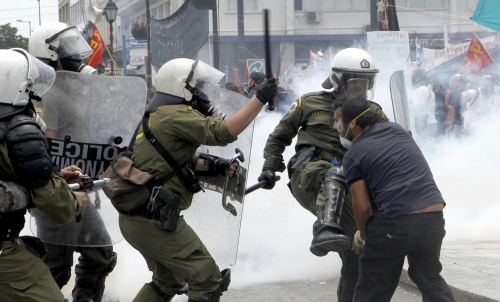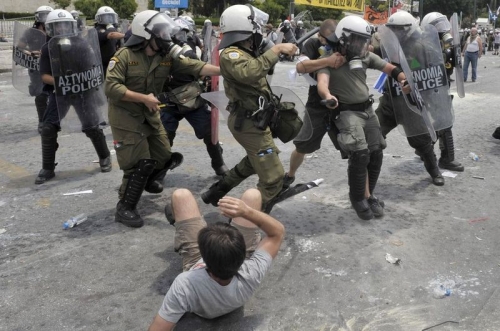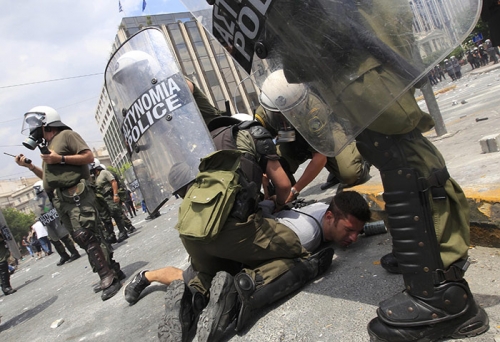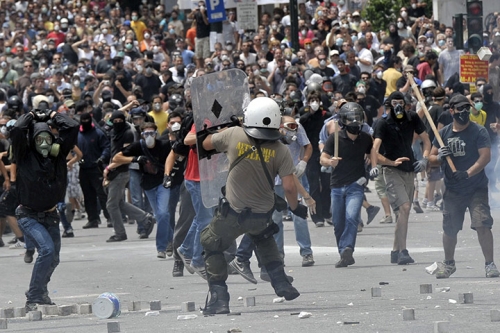The Battle for Syntagma: an eyewitness report
- July 6, 2011
People & Protest
A very insightful personal report on the historic events surrounding the 48-hour strike and anti-austerity demonstrations in front of Greek parliament last week.
- Author
This is a personal report from an outsider in Greek society who was inside the protests over the past week. It is hoped that this report, which is a mix of general reporting and personal experience and which must surely be flawed at some points due to lack of information or confusion, will provide some inside information to people across the world about what has been happening in Greece.
Dire circumstances
Plenty has been written about the economic attack on the Greek people by the banks and states of the West. This article is meant as a report from within the resistance against this attack. But in short, the Greek people are being made to pay for the financial crisis that was caused by international banks, states and corporations. It is said Greece is in debt. But two questions have to be asked: 1) Who is “Greece”? 2) To whom are they in debt?
T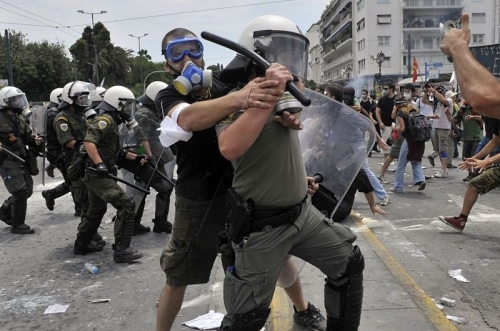 he answer to the first question is that when corporate media talk about Greece being in debt, they talk about the Greek people, but in reality it is the Greek state. A state that is everything but democratic, and does not work in the interest of its citizens. Still, the measures that are forced through will be hurting the Greek people, who hardly benefited from the money that the Greek state borrowed. The answer to the second question is international financial corporations, the same ones that should be held responsible for the current crisis. They have willingly and knowingly pushed through loans to Greece and others, often through their good connections with the state managers. Now that new loans have to be initiated, it’s the same banks that are “helping” the state managers achieve this. Especially the advisers of Goldman Sachs play a prominent role behind the scenes. What they are helping with is selling of the public property of Greece to speculators, rich people elsewhere, and so on. They are helping to increase unemployment, lower the wages, and privatize public services. It is self-evident that such acts will be highly profitable for the corporations that are involved, and will cause a lowering of the life standards of the average Greek people. And all Greeks can attest to this; everyone I talked to seemed to have either a personal story or of people they knew that lost their jobs, whose wages were cut in one way or the other, PhD’s who had to take up jobs in supermarkets to survive, or people who were just jobless for endless amounts of time, depending on family and friends for survival.
he answer to the first question is that when corporate media talk about Greece being in debt, they talk about the Greek people, but in reality it is the Greek state. A state that is everything but democratic, and does not work in the interest of its citizens. Still, the measures that are forced through will be hurting the Greek people, who hardly benefited from the money that the Greek state borrowed. The answer to the second question is international financial corporations, the same ones that should be held responsible for the current crisis. They have willingly and knowingly pushed through loans to Greece and others, often through their good connections with the state managers. Now that new loans have to be initiated, it’s the same banks that are “helping” the state managers achieve this. Especially the advisers of Goldman Sachs play a prominent role behind the scenes. What they are helping with is selling of the public property of Greece to speculators, rich people elsewhere, and so on. They are helping to increase unemployment, lower the wages, and privatize public services. It is self-evident that such acts will be highly profitable for the corporations that are involved, and will cause a lowering of the life standards of the average Greek people. And all Greeks can attest to this; everyone I talked to seemed to have either a personal story or of people they knew that lost their jobs, whose wages were cut in one way or the other, PhD’s who had to take up jobs in supermarkets to survive, or people who were just jobless for endless amounts of time, depending on family and friends for survival.
One month Syntagma
Amidst the dire circumstances of economic warfare by the combined forces of state capitalism, the people in Athens took up the example of Spain by camping on the central square of the capital – which in Athens also houses the parliament. Since the 5th of May people have occupied Syntagma square and are holding daily assemblies, open to anyone, to decide upon their goals, demands, actions and more. Overall, thousands have been participating, with several hundred sleeping there as well. Sundays are the biggest, with thousands of people, many of whom are standing on the upper parts of Syntagma, in front of parliament. These crowds are even more mixed, with nationalist forces and slogans more present (and now and then fascists trying to mingle among them as well). But in general such tendencies (including anti-immigrant slogans) are few and countered well. For instance, the few Greek flags that are there are countered by the flags of Egypt, Tunisia, Spain, and others, to show that we’re in the same struggle.
Without many anti-authoritarians or anarchists being there, the assembly decided on its second day to be based on the principle of direct democracy. Around 90% voted for this over “real democracy,” which had connotations of “improving parliamentary democracy,” “replacing the corrupt politicians with better ones,” and so on. Now one of the main banners in front of the parliament calls for Direct Democracy. And by their actions the people show what creative power lies in the cooperation of the masses. Next to the many tents, information stands, a media center, a medical station, a cooking area, and many more things have been created. Moreover, recycling is brought to new levels, with different color garbage bags for different materials. Regularly one can see people sweeping and cleaning the square.
 But perhaps the most impressive are the big assemblies. High quality boxes have been installed (donated by a famous Greek singer, who wants to stay anonymous so as not to take any credit), and people can come forward to the central microphone to give their opinions, which are heard by everyone present. The previous speaker has left center stage, an impressive quiet ensues in anticipation of the next speaker. Ninety-nine percent of the people are extremely respectful towards the speakers; if they stumble over their words they are encouraged to continue by the crowd. People have agreed upon signs to show approval and other feelings, without disrupting the speaker too much. Opinions verging on racism or strong nationalism are booed, but in general people are given a lot of leeway.
But perhaps the most impressive are the big assemblies. High quality boxes have been installed (donated by a famous Greek singer, who wants to stay anonymous so as not to take any credit), and people can come forward to the central microphone to give their opinions, which are heard by everyone present. The previous speaker has left center stage, an impressive quiet ensues in anticipation of the next speaker. Ninety-nine percent of the people are extremely respectful towards the speakers; if they stumble over their words they are encouraged to continue by the crowd. People have agreed upon signs to show approval and other feelings, without disrupting the speaker too much. Opinions verging on racism or strong nationalism are booed, but in general people are given a lot of leeway.
Although plenty of debate is possible over how democratic such big open assemblies are, they are certainly much more democratic than anything known in current society. It’s surprising how well it functions, considering its size (often hundreds of people, and at some nights even more). Now and then there is some (verbal) fight over the microphone, when someone is talking too long; now and then there are some hotheaded people, but in general these things solve themselves. The same holds for what people have to say; sometimes discussions are slow, with a lot of repetition and apparent irrelevancy, and sometimes people even start talking about a personal problem they had with the state or some institution.
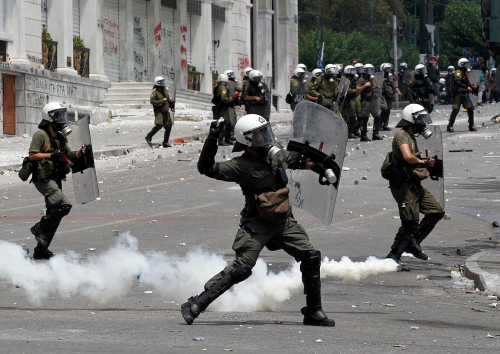 But this should not discourage anyone. We should be open and understanding, however difficult it might be at times. People come to such assemblies with the values of the old society still in them. It is in the course of discussions, of actions, and of active participation that people start to change themselves as well. By its very being, and by people participating in it, people gain the needed experience for true democracy. And although many Greeks don’t know much about the gatherings on Syntagma, since the corporate and state media are scarcely reporting on it, polls seem to show that a large majority (70+ %) support what’s happening.
But this should not discourage anyone. We should be open and understanding, however difficult it might be at times. People come to such assemblies with the values of the old society still in them. It is in the course of discussions, of actions, and of active participation that people start to change themselves as well. By its very being, and by people participating in it, people gain the needed experience for true democracy. And although many Greeks don’t know much about the gatherings on Syntagma, since the corporate and state media are scarcely reporting on it, polls seem to show that a large majority (70+ %) support what’s happening.
There are also neighborhood assemblies, many already existing for years – many since the events of December 2008 (the murder by the police of a young boy, followed by massive protests and riots). However, these are often more dominated by political parties/groups, different factions fighting for different directions of the assemblies. On Syntagma they have failed in their attempts. For instance, last week Friday a faction, ARAS, of the revolutionary socialist coalition Antarsya brought 50 people to a separate assembly on Syntagma, which was going to define what the group was and wanted, to vote for their text. Two days later, in the general Assembly, this decision was overturned and postponed for full discussion in the general Assembly. And if one looks at the texts that have so far been produced on Syntagma, one cannot be but excited about the capacities of people to think for themselves, without dogmatic political groups enforcing their strict ideas on them. By this they also show how well people can cooperate without having to agree with each other on every single point.
A Mix of Anger, Hope and Fear
The days leading up to the 48 hour strike were days of mixed feelings. On the one hand, I heard several Greek friends talk in a way I had never heard them talk. These were the days where it had to happen, they said. There is no return. We have to give everything. I heard non-black blockers say that maybe we had to put the whole city on fire. We had to make it impossible for the government to vote through the new “loans,” i.e. the destruction of everything social and public in Greece.
At the same time fear was hanging in the air. Police violence had been increasing, everything was intensifying. Days before the strike, vice President and Minister of Finance Theodoros Pagalos had said publicly that if the measures don’t make it through parliament now, they would have to call in the military and place tanks on the streets. It’s no surprise, then, that some of my friends told me they were really afraid people were going to get killed during the strike. With this mix of feelings in mind, we proceeded to the first day of what may properly be called, “the Battle for Syntagma.”
The Battle for Syntagma
Day 1: June 28
As always, different groups and people assembled on different points in the city. This time some directly assembled on Syntagma, instead of walking there as a group, to protect the camp and have a big presence there. But it was the first time in decades that there was a 48-hour strike, and no one knew what to expect on this first day, especially since the vote was going to be on the next day. For that reason some of my friends said that today had to be the day we created a situation that made it impossible for the government to do anything, but it seemed that most unions and people were focusing on the next day.
In other words, the numbers on the first day were relatively low, especially early on the day when the heat was agonizing. (Normally, summers are a period in Greece where there is a lull in the protests due to the heat.) Later on the day the numbers increased, but probably were never higher than around fifty thousand.
As always, Parliament was blocked off by well-prepared fences and long lines of riot police. But at some point of the day, maybe around 13.00, the police decided to place riot units on the sides of the square. The hatred against the extremely violent and provocative police in Greece is immense, and people wouldn’t stand for it. They started shouting to the police to go away, trying to block them off. The police started pushing people, some water bottles started flying, the police had to back down, and the first tear gas grenades were fired, and some stones were thrown at the police.
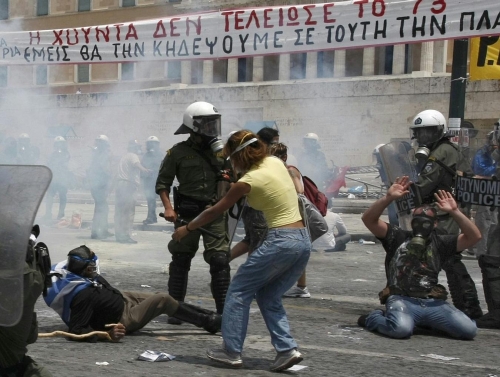 Around that point, the group of black blockers, who were sitting segregated from the rest of the people in one corner of the square until that point, started moving to the sides of the square and fights with the police ensued. Even though the numbers on the square were low, and it was essential to keep the square, they decided to engage in massive fights with the police; mostly by throwing stones, accompanied by destroying and putting on fire some things here and there. Their presence that day was very negative, segregated from the people, acting as some avant-garde fighting force, deciding for the people. Many people were upset, because they feared that 1) this was very risky, since we weren’t with too many people, 2) this violence would increase the fear in society, and would keep a lot of people away the next day. The violence also didn’t seem to have any clear goal. But more importantly, the way many of them acted towards other protesters was sickening. There were many incidents of people trying to convince them of not throwing stones at this or that particular point or place. This often resulted in heated discussions with many people gathering around it, and just as often with aggressive responses by the black blockers, sometimes event violent. To give two dreadful examples: 1) In one such discussion the black blocker, after a while, walked up to the man (a fellow protester) he had a heated discussion with, and hit him on the head with a long thick wooden stick, knocking the man unconscious. 2) The second example evolved around a van of a TV-station that was on fire. One protester walked up to it with a fire extinguisher, intending to put out the fire. Other people shouted at him to let the van burn. It came to some pushing and pulling, and eventually one brainless idiot started to hit the man. When they were both back in the lower inside part of Syntagma the discussion continued. At this point the black blocker took out a big hammer, threatening him with it. At that point the guy previously with the fire extinguisher flipped and dared him to do it – luckily other people pulled him away. And that is the only positive point in this, namely that there were often many people trying to separate the hotheads.
Around that point, the group of black blockers, who were sitting segregated from the rest of the people in one corner of the square until that point, started moving to the sides of the square and fights with the police ensued. Even though the numbers on the square were low, and it was essential to keep the square, they decided to engage in massive fights with the police; mostly by throwing stones, accompanied by destroying and putting on fire some things here and there. Their presence that day was very negative, segregated from the people, acting as some avant-garde fighting force, deciding for the people. Many people were upset, because they feared that 1) this was very risky, since we weren’t with too many people, 2) this violence would increase the fear in society, and would keep a lot of people away the next day. The violence also didn’t seem to have any clear goal. But more importantly, the way many of them acted towards other protesters was sickening. There were many incidents of people trying to convince them of not throwing stones at this or that particular point or place. This often resulted in heated discussions with many people gathering around it, and just as often with aggressive responses by the black blockers, sometimes event violent. To give two dreadful examples: 1) In one such discussion the black blocker, after a while, walked up to the man (a fellow protester) he had a heated discussion with, and hit him on the head with a long thick wooden stick, knocking the man unconscious. 2) The second example evolved around a van of a TV-station that was on fire. One protester walked up to it with a fire extinguisher, intending to put out the fire. Other people shouted at him to let the van burn. It came to some pushing and pulling, and eventually one brainless idiot started to hit the man. When they were both back in the lower inside part of Syntagma the discussion continued. At this point the black blocker took out a big hammer, threatening him with it. At that point the guy previously with the fire extinguisher flipped and dared him to do it – luckily other people pulled him away. And that is the only positive point in this, namely that there were often many people trying to separate the hotheads.
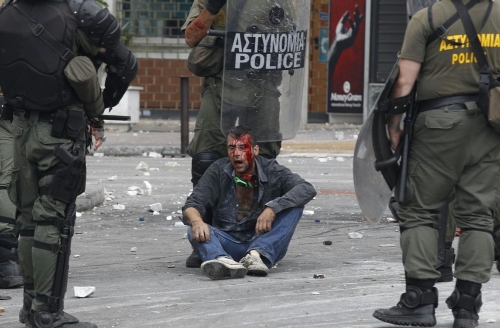 Many of these black blockers seemed to regard violence/violent resistance as an overall principle, instead of a tactic that one should think about and use in a smart way when necessary or useful. Also, it wasn’t clear whether these people were against injustice, the state and corporations, or also against the people outside their own circle in general. This day was the day when I finally understood why my friends from the Anti-Authoritarian Movement in Greece (known as Alfa Kappa) did not call themselves anarchists, even though they fall well within the worldwide tradition of (social) anarchism.
Many of these black blockers seemed to regard violence/violent resistance as an overall principle, instead of a tactic that one should think about and use in a smart way when necessary or useful. Also, it wasn’t clear whether these people were against injustice, the state and corporations, or also against the people outside their own circle in general. This day was the day when I finally understood why my friends from the Anti-Authoritarian Movement in Greece (known as Alfa Kappa) did not call themselves anarchists, even though they fall well within the worldwide tradition of (social) anarchism.
Returning to the protest, we should not forget that there were also, as always, undercover police provocateurs, although it’s often hard to determine which acts are done by whom. One instance where a provocateur was discovered was when a friend of mine got into an argument with a man who was constantly telling others to use violence. After some talk both were to show their ID cards to prove they were not undercover police. The man showed his very quickly, and then turned around; two seconds later he started running. We chased him with a big group, but he found refuge in a medical post inside the metro station. But the existence and presence of provocateurs should not blind us for what everyone knows: there are also bad tendencies within the movement that we need to talk about, that we need to change; we need to socialize our own movement; it’s always easy to point to others, but we should never stop criticizing ourselves.
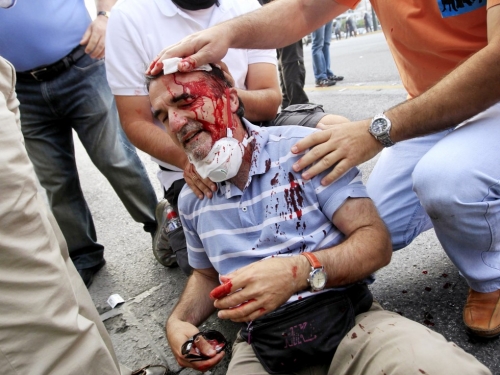 Later, the scene got more and more dominated by other protesters, some singing songs and slogans, also trying to keep the square, defend it against the police, but without throwing stones at everything that moves. Still, even though the overwhelming majority did not seem to be in the mood for violent resistance, small groups of black blockers continued, resulting in more and more tear gas attacks. Towards the evening, around 18.00, things started to quiet down.
Later, the scene got more and more dominated by other protesters, some singing songs and slogans, also trying to keep the square, defend it against the police, but without throwing stones at everything that moves. Still, even though the overwhelming majority did not seem to be in the mood for violent resistance, small groups of black blockers continued, resulting in more and more tear gas attacks. Towards the evening, around 18.00, things started to quiet down.
When the police had largely withdrawn, at least for the time being, it was time for one of the most beautiful acts of people’s collective power that I’ve ever experienced. Spontaneously, long human chains started forming themselves, extending from the fountain at the middle of the square to all the outer parts. From the fountain people started filling plastic bottles with water, passing them along the chain; at the end of the chain the water was thrown on the pavement to clear it of all the chemicals that had been thrown by the police.; the empty bottles went back via another chain, to be refilled at the fountain once again. This process went on for maybe an hour, until all streets and stones were clean again, thereby cleansing the air and enabling people to breath freely again. Everyone seemed to participate. The notable exceptions in this social event of human cooperation were the individualist black blockers who had thrown most of the stones.
 There were also groups, most prominently PAME, the union of the Stalinist Communist Party, which only passed Syntagma in the morning and late in the evening, but let the occupation of and battle for the square to others. On their return in the evening they were booed extensively, with white-faced people asking them angrily where they had been when they had to take all the tear gas and other police attacks.
There were also groups, most prominently PAME, the union of the Stalinist Communist Party, which only passed Syntagma in the morning and late in the evening, but let the occupation of and battle for the square to others. On their return in the evening they were booed extensively, with white-faced people asking them angrily where they had been when they had to take all the tear gas and other police attacks.
From 19.00 o’clock onwards the number of people began to increase again. The police continued with the firing of tear gas now and then, but everyone was determined to stay – also old people, with their faces whitened from the anti-tear gas substance “maalox,” were defiant and this unity inspired us all. This process continued all evening, with numbers dwindling. One characteristic moment was the concert that was organized in the middle of tear gas clouds. People gathered around the artists, which included very famous Greek artists, and also the very popular English band Tiger Lillies, who themselves requested to play there for free (normally they play in big halls with tickets going for €50). Around 2.00 o’clock things quieted down again, and the people who would stay the night could finally try to settle down in their tents.
The tear gas, nor the other violence, could clear the square. People were determined to stay. These are our times. Some people left, taking a rest, and other people took their place. And one point in the day one could be challenging the authority of the state police, and another point one would be going around with spray cans of “maalox” to help the people that are forced back by the tear gas and have burning eyes or respiratory problems; at yet another point one would be taking a rest or cleaning the streets. All with the same thing in mind: these streets are ours.
Day 2: June 29
(Due to the events of this day, I couldn’t make any notes; too busy! Most of the following is from memory. Also, I will leave in the middle what I did personally, for reasons people will understand.)
Today was going to be the day. Parliament was to vote, and we had to stop it. To be honest, after the day before, there did not seem to be much confidence that the vote could be prevented. Still, the anger in society was immense, and today people from all over Greece were coming to Athens.
In the morning everyone seemed to be out to buy gas masks. A friend bought some at a paint store, and the first thing the man behind the desk asked was: “Gas mask?” He was almost out of them. Several boxes, which hours before had been full of masks, were lying on the floor empty. Today, much more than yesterday, people came well-prepared. The day before there had been quite some people who had no experience with tear gas and police violence. That day their eyes were opened, and they came prepared against the unprecedented amounts of tear gas of the previous day.
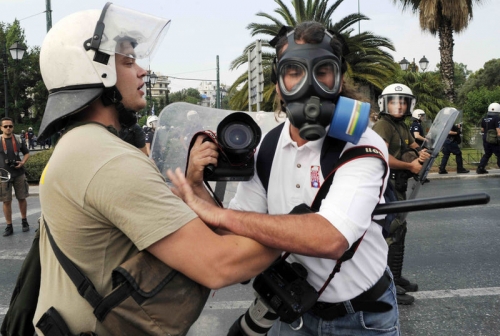 In the morning there was supposed to be a blockade of parliament, at three points – one of which was Syntagma. The police succeeded in dispersing the crowds with heavy violence at the other two points, and that part of the day didn’t seem to be a success. But as the day grew older, more and more people came to Syntagma. The Stalinists of PAME were with tens of thousands, but stopped short of Syntagma and turned around. But all those who were allowed an own opinion seemed to be determined to enter. All streets leading to Syntagma were full of people; as far as the eye could see. This was massive. These were at the very least 100.000 people.
In the morning there was supposed to be a blockade of parliament, at three points – one of which was Syntagma. The police succeeded in dispersing the crowds with heavy violence at the other two points, and that part of the day didn’t seem to be a success. But as the day grew older, more and more people came to Syntagma. The Stalinists of PAME were with tens of thousands, but stopped short of Syntagma and turned around. But all those who were allowed an own opinion seemed to be determined to enter. All streets leading to Syntagma were full of people; as far as the eye could see. This was massive. These were at the very least 100.000 people.
The fights that erupted this day were something completely different than the day before. This was not just by some avant-garde dressed in black, everyone seemed to be determined. Not by throwing stones per se, although this form of resistance also happened on a massive scale by all types of people, but also by pulling away the fences in front of parliament, forcing the police to come to the front, attacking the people on a massive scale, with all kinds of tear gas, flash bombs, and, all day long, with stones (best seen here)! It seemed that when the police was not firing tear gas, they were throwing stones. There was no end to it.
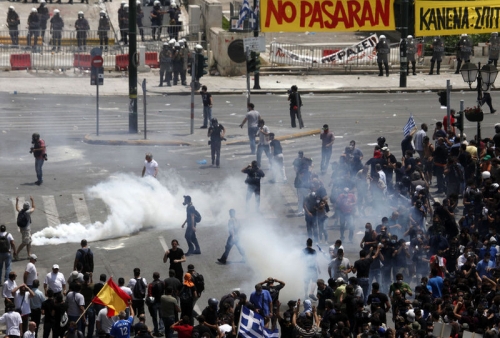 And this time it was all over; on all sides of the square people tried to chase the police away. Some by blockades, sitting on the ground, others by stones, sticks and barricades. But also people who were not on the square, either of fear, due to police blockades, or because they just could not stand the massive chemical attacks, came back again and again, filling the streets leading to Syntagma, supporting the fight, challenging the police in their own way. In many streets around the square these people were chased for kilometers by the police; most notoriously by the police on motorbikes (DIAS) who dangerously drove into them, throwing tear gas in crowds, in shops, restaurants, hitting everyone, including unknowing tourists. Everything to keep the people of Syntagma.
And this time it was all over; on all sides of the square people tried to chase the police away. Some by blockades, sitting on the ground, others by stones, sticks and barricades. But also people who were not on the square, either of fear, due to police blockades, or because they just could not stand the massive chemical attacks, came back again and again, filling the streets leading to Syntagma, supporting the fight, challenging the police in their own way. In many streets around the square these people were chased for kilometers by the police; most notoriously by the police on motorbikes (DIAS) who dangerously drove into them, throwing tear gas in crowds, in shops, restaurants, hitting everyone, including unknowing tourists. Everything to keep the people of Syntagma.
Back on Syntagma the banks and hotels for the rich (where the IMF and EU people normally stay as well) around the square were now attacked as well. One hotel had to be evacuated. The McDonalds got opened and people were taking out material for barricades. The State post office under the Ministry of Finance was set on fire. Some molotov cocktails were thrown on the police. The pavement on Syntagma and of the rich hotels was opened up and used as munition. Wooden benches were taken apart to make fires, which were necessary as an extra repellent against the tear gas, around which people could clear their eyes and breath once more. If ever the stereotyped phrase of Bakunin, that the passion for destruction is also a creative passion, could be understood, it was today.
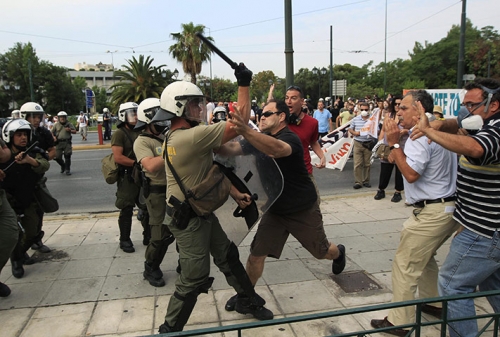 A yuppie bar on the lower level of Syntagma was raided as well, with people taking out the fancy foods and ice creams to eat, the tables to burn, the chairs to sit on, other things to place barricades on top of the stairs so the police could not come in. In this, it was again disappointing to see that most of the individualists just tried to keep the fancy foodstuff for themselves. On the other hand, can one blame them? Most of them have probably never had the luxury to eat such foods. Why should today not be their turn? Luckily some others were walking around with plates full of cookies, ice cream, and so on, to hand out to the people. This was a beautiful sight; people were delighted, a moment of happiness and enjoyment in the midst of a war zone. These things kept the spirit up. The way people helped each other, trying to make it through the day all together, helping where one could.
A yuppie bar on the lower level of Syntagma was raided as well, with people taking out the fancy foods and ice creams to eat, the tables to burn, the chairs to sit on, other things to place barricades on top of the stairs so the police could not come in. In this, it was again disappointing to see that most of the individualists just tried to keep the fancy foodstuff for themselves. On the other hand, can one blame them? Most of them have probably never had the luxury to eat such foods. Why should today not be their turn? Luckily some others were walking around with plates full of cookies, ice cream, and so on, to hand out to the people. This was a beautiful sight; people were delighted, a moment of happiness and enjoyment in the midst of a war zone. These things kept the spirit up. The way people helped each other, trying to make it through the day all together, helping where one could.
But it was a tough day. It is a tribute to the human spirit that the people persevered. As mentioned before, the police was throwing stones in crowds of people, the police was firing tear gas and explosives inside the camp, with a mass of people that had nowhere to go. The tear gas was so severe that when the head of the union of pharmacists came live on TV and said that the tear gasses that were used were prohibited under international law when used in wars, and moreover were over date and dangerous, he fainted from the very same tear gas, live on TV. At several points in the day, the police came inside the camp. Sometimes it seemed we couldn’t hold ground, but every time we pushed back. (One of the most difficult moments is seen here.) Most people did so just by the power of numbers, the power of being there together and not going away. Others tried to defend the square against the incoming police with stones, others with sticks. This was too much for the police, they had to pull back. Their only other option was to chase the people inside the metro station where they were fleeing and from which they kept returning, but this would have created such chaos and so many heavy injuries that Greek society would surely resist even more intensively; the legitimacy of the government was in serious danger.
 But the camp was in a dilapidating condition, much of it ruined by fleeing people, the police, and chemicals, and some of it had to be used for fires. This day there was not going to be a lull in the fighting; this day there was no time to form human chains to clean the pavement. It really was a battle for the survival of the camp. As more and more people were injured (some seriously), many by the stones thrown by the police, and people started getting exhausted from the tear gas, the running around, and the tension, people started leaving and numbers went down. Also, the sound installation was abandoned (until then, every time there was tear gas a voice was heard over the entire square, telling people to stay calm, to go to the people with bottles of “maalox” to put in their eyes, and so on). But until late at night the amount of people present was massive. And still, until the last metro, new people arrived or came back.
But the camp was in a dilapidating condition, much of it ruined by fleeing people, the police, and chemicals, and some of it had to be used for fires. This day there was not going to be a lull in the fighting; this day there was no time to form human chains to clean the pavement. It really was a battle for the survival of the camp. As more and more people were injured (some seriously), many by the stones thrown by the police, and people started getting exhausted from the tear gas, the running around, and the tension, people started leaving and numbers went down. Also, the sound installation was abandoned (until then, every time there was tear gas a voice was heard over the entire square, telling people to stay calm, to go to the people with bottles of “maalox” to put in their eyes, and so on). But until late at night the amount of people present was massive. And still, until the last metro, new people arrived or came back.
At 23.00 o’clock another police provocateur was discovered; his bag contained his cloths to change, and his belt, including his gun – I can attest for the presence of his clip full of bullets. He also was whisked away to safety by medical personal. Reports said that around 2.00 o’clock things were relatively quiet again.
Day 3: June 30
Some of the people sleeping in the square returned at night, and tried to make it livable. But most of it had to be done the next day, Thursday. An assembly was called for at 18.00. Again, thousands of people came. The streets were closed off to cars again, because there were just too many people on them, over the entire square surely 5.000.
Again, human chains were formed to clean the square. Things were being rebuilt, some others moved. There was some police at the bottom end of the squares, but every time they even set a step in the direction of the square they were booed.
As I am writing this, on Friday the 1st of July, we can hear the live radio broadcast from Syntagma. Today people will gather again. Not on the scale of the general strike, obviously. But the resistance continues and is growing. No one can predict what will come of this, and if the people of Greece will succeed in their fight against the collected forces of capitalist enterprises and European states. One thing I do know: I now have to stop writing, and go there
Source URL — https://roarmag.org/essays/the-battle-for-syntagma-an-eyewitness-report/


